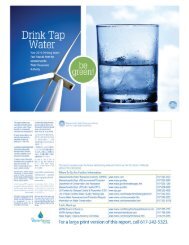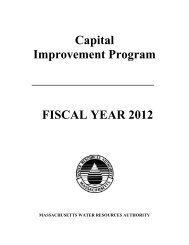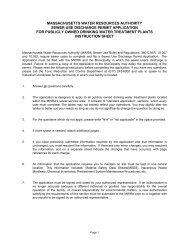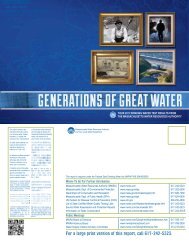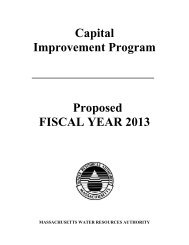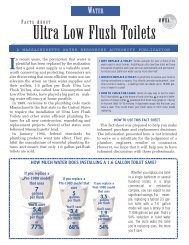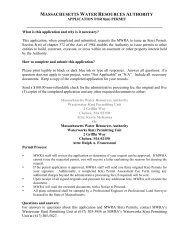Quarter 2 - Massachusetts Water Resources Authority
Quarter 2 - Massachusetts Water Resources Authority
Quarter 2 - Massachusetts Water Resources Authority
- No tags were found...
You also want an ePaper? Increase the reach of your titles
YUMPU automatically turns print PDFs into web optimized ePapers that Google loves.
Algae in the Source <strong>Water</strong>2nd <strong>Quarter</strong> – FY13Algae levels in Wachusett Reservoir are monitored by DCR and MWRA. These results, along with taste and odorcomplaints, are used to make decisions on source water treatment for algae control.Taste and odor complaints at the tap may be due to algae, which originate in source reservoirs, typically in traceamounts. Occasionally, a particular species grows rapidly, increasing its concentration in water. When Synura,Anabaena, or other nuisance algae bloom, MWRA may treat the reservoir with copper sulfate, an algaecide. Duringthe winter and spring, diatom numbers may increase. While not a taste and odor concern, consumers that use filtersmay notice a more frequent need to change their filters.In the 2nd <strong>Quarter</strong>, there were no complaints related to algae reported from local water departments.Algae densities are extremely low this quarter. Flat calm conditions on the reservoir on October 17 combined with thelow densities contributed to an exceptional measurement of water clarity. An all-time record for Secchi transparencyat Wachusett was recorded at 36.5 feet. The prior record of 34 feet was first recorded on Dec. 11, 2007 and wasobserved again on Nov. 3, 2010.30002400Total Algae at Wachusett ReservoirMaximum LevelReservoir treated w/ copper sulfate30002400Total Diatoms at Wachusett ReservoirMaximum Levelasu/mL180012006000Dec-11 Mar-12 Jun-12 Sep-12 Dec-12asu/ml180012006000Dec-11 Mar-12 Jun-12 Sep-12 Dec-12Drinking <strong>Water</strong> Quality Customer Complaints: Taste, Odor, or AppearanceMWRA collects information on water quality complaints that typically fall into four categories: 1.) discoloration due toMWRA or local pipeline work; 2.) taste and odor due to algae blooms in reservoirs or chlorine in the water; 3.) whitewater caused by changes in pressure or temperature that traps air bubbles in the water; or 4.) “other” complaintsincluding no water, clogged filters or other issues.MWRA routinely contacts communities to classify and tabulate water complaints from customers. This count,reflecting only telephone calls to towns, probably captures only a fraction of the total number of customer complaints.Field Operations staff have improved data collection and reporting by keeping track of more kinds of complaints,tracking complaints to street addresses and circulating results internally on a daily basis.Communities reported 69 complaints during the quarter. Of these complaints, 34 were for “discolored water”, 26were for “taste and odor”, 1 was for “white water”, and 8 were for “other”. Of these complaints, 4 were MWRArelated, 35 were local community issues, and 30 were unknown.of Complaints#5045403530252015105<strong>Water</strong> Quality ComplaintsTaste and OdorDiscoloredWhite <strong>Water</strong>OtherData Gap0Dec-11 Feb-12 Apr-12 Jun-12 Aug-12 Oct-12 Dec-12of Complaints# o5045403530252015105Trends in <strong>Water</strong> Quality ComplaintsFY11 - FY2012Data Gap0Dec-11 Feb-12 Apr-12 Jun-12 Aug-12 Oct-12 Dec-12* Outgoing calls to communities were interrupted during a portion of FY12 and resumed during Q1 FY13, thus, some results are notdirectly comparable with historical data.23




